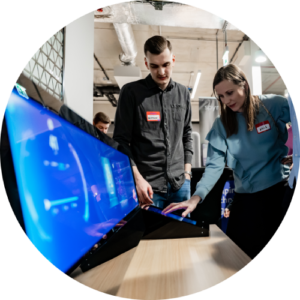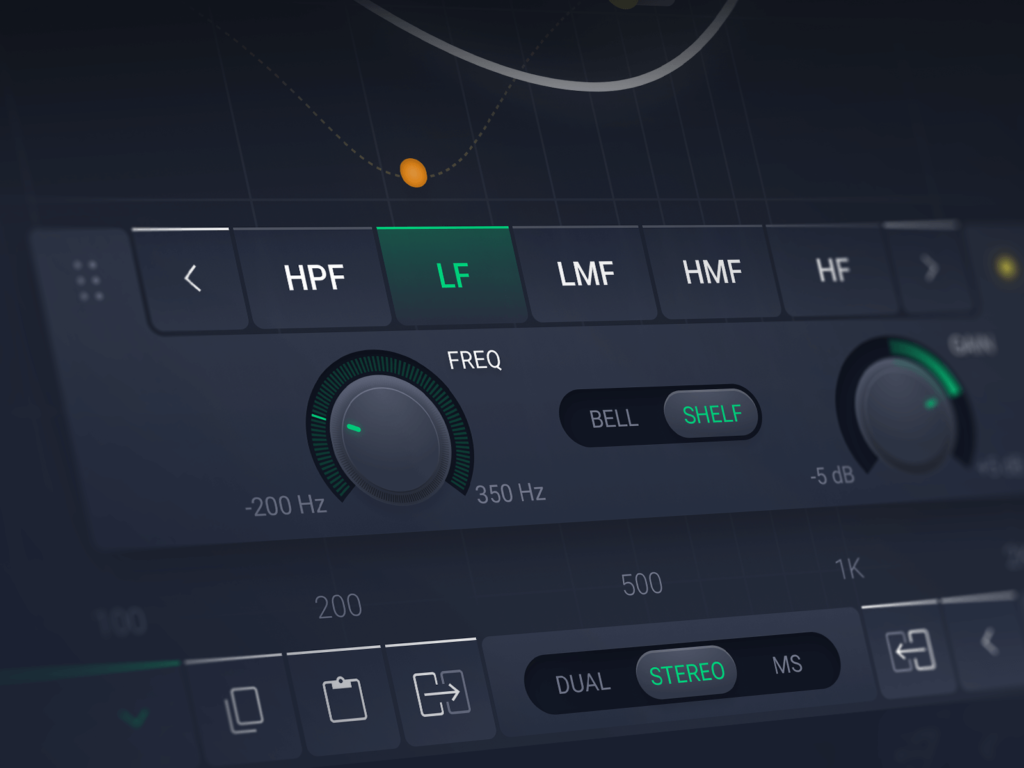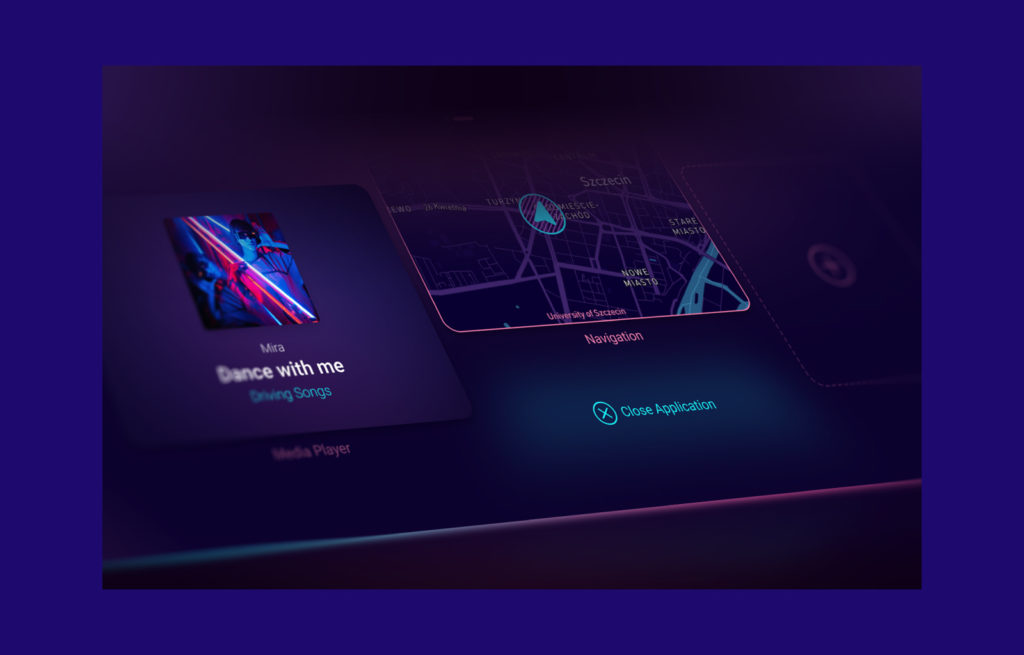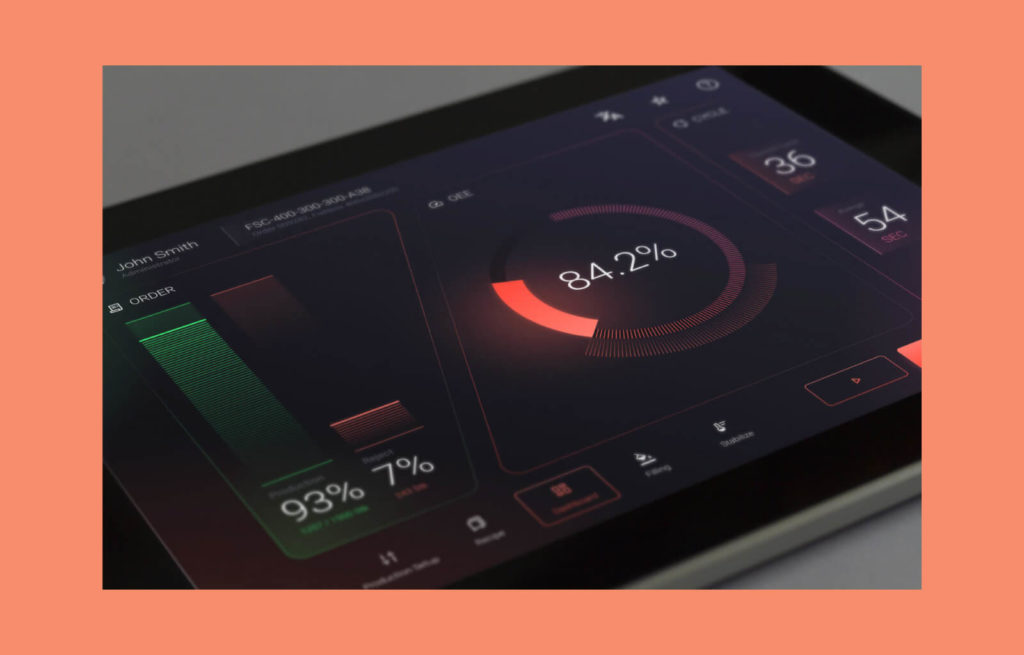Marine HMI: Designing Modern HMIs for Yachts with Qt and NMEA 2000
As the marine industry embraces digital transformation, Human-Machine Interfaces are redefining how crews, operators, and manufacturers interact with onboard systems. These solutions not only improve safety and efficiency but also elevate the onboard experience. Whether you’re cruising on a luxury yacht or running a commercial vessel, the right HMI setup can make all the difference. Have a look at our ready-to-use Marine HMI for yachts and small vessels.
A Human-Machine Interface (HMI) is the bridge between people and onboard systems. It’s how operators interact with the vessel’s tech. Marine HMI pulls together everything from lighting and bilge pumps to power distribution into one clean, intuitive interface. This results in smarter control, fewer manual tasks, and a much more seamless onboard experience.
Yacht design used to be all about form and performance: think teak decks, brass details, and rows of analogue dials. As materials and tech evolved, we saw the rise of fiberglass hulls and digital gauges. But behind the scenes, many control systems stayed stuck in the past: bulky switches, endless wiring, and old-school breakers.
From analogue dials to touchscreens
As the boating world embraces the digital age, we’re seeing the same transformation in marine HMI that already reshaped the automotive industry. Just like dashboards evolved from analogue gauges to sleek touchscreens and integrated systems in modern cars, boat control panels are shifting from rows of toggle switches and breakers to smart marine UI.
The move toward smart marine control panels isn’t just a tech upgrade. It’s a whole new design mindset. Today’s yacht owners expect more than just functionality. They want intelligent interfaces that match the luxury and innovation of their cars, homes, and even airplanes.
Modern yacht design is driven by efficiency, sustainability, and personalisation. Owners want systems that use less power, take up less space, and make life on board smoother and more enjoyable.
Smart marine control panels are stepping up to meet these demands:
- Less wiring means lighter boats and simpler maintenance
- No moving parts lead to fewer failures and longer-lasting systems
- Programmable switches offer flexibility tailored to every voyage
- Bluetooth remote access ensures safer, more convenient control
These innovations perfectly match wider marine trends like hybrid propulsion and solar energy where every system needs to work smarter, not harder.
At Spyrosoft, we design and develop marine HMI solutions using Qt technology and the NMEA 2000 communication standard. Our HMIs are intuitive, responsive, and standards-compliant, with a strong focus on sleek design, rock-solid reliability, and seamless system integration.
If this is what you need, stay with me to learn about our Marine HMI.
What is Marine HMI?
We offer a pre-configured system template with full integration of engines, sensors, user interface, and other key components. It significantly reduces time-to-market by providing a solid, ready-to-use foundation.
You can easily customise the look and feel of the system, including branding, colours, and the scope of functionality, making it a flexible starting point tailored to specific project needs.
The setup includes two displays and data sourced from the NMEA 2000 protocol.
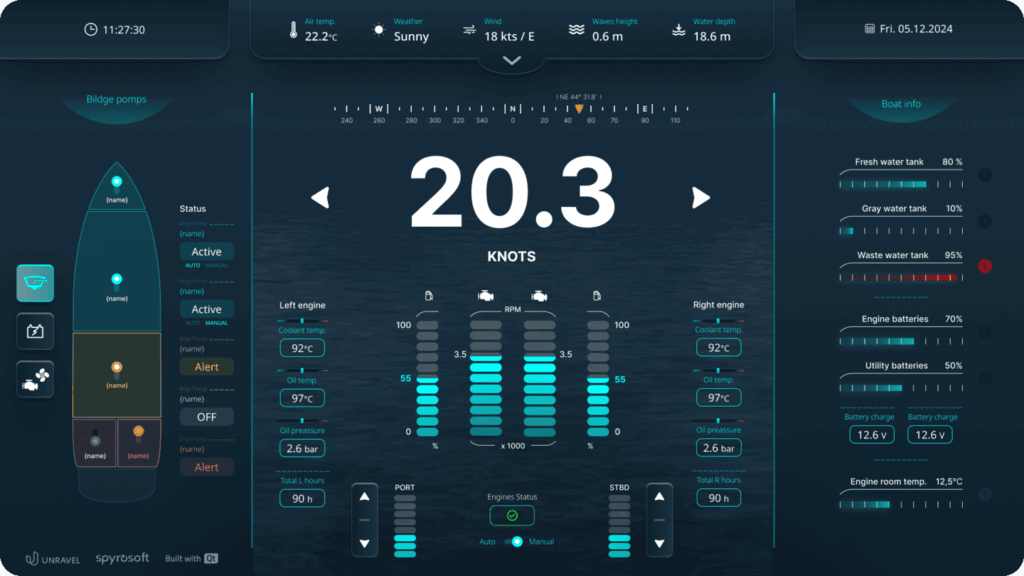
The system architecture is based on Qt/QML running on a single board computer, for example Raspberry Pi, with full flexibility to customise both the hardware setup and display configuration. Any Linux-based system can be used.

If you want to see how Marine HMI works on your vessel, contact us to arrange a live demo on your hardware.
Key features
The system supports a wide range of core functionalities, including:
• Integration with engines, tanks, sensors, weather data, pumps, maps, navigation, and autopilot
• Custom features can also be added to fit specific use cases or user needs
• The user interface is designed with clarity, intuitive navigation, accessibility, and full branding flexibility in mind, ensuring a smooth experience whether on land or at sea
• It enables full control and monitoring of engines, tanks, sensors, and pumps.
• The navigation module provides access to maps, real-time positioning, route guidance, and live weather data.
• System information includes key operational parameters such as position, course, heading, speed, fuel level, engine RPM, temperature, and more, delivered in a clear and accessible format
Each iteration of Marine HMI was shaped by direct feedback from experienced yacht users, so the solution meets real-world needs on the water. Unlike automotive systems, maritime environments require a different set of priorities and data visibility. That’s why we focused on adapting the interface and functionality to reflect what matters to yacht operators.
Streamlining navigation and system control
Managing diverse onboard systems, such as navigation, bilge pumps, and lighting, has traditionally involved multiple discrete controls, increasing complexity and the potential for operator error. Modern marine HMI solutions consolidate these functions into a unified, touchscreen interface that centralises command and monitoring.
Operators gain real-time access to critical data like weather conditions, fuel consumption, and route planning, all presented on a single interactive display. This integration enhances situational awareness and operational efficiency.
From adjusting lighting and monitoring bilge pump performance to controlling the windlass, the system provides precise, programmable control, reducing workload and improving reliability in complex marine environments.
Enhancing safety at sea with Marine HMI
In marine environments, safety is non-negotiable. Operating in unpredictable conditions demands systems that support fast, informed decisions. That’s where marine HMI solutions come in. They give operators real-time access to essential onboard functions through a central, intuitive interface.
While these systems don’t replace dedicated navigation or engine monitoring tools, they act as a reliable hub, bringing together data from multiple subsystems. Whether it’s a low battery warning, a bilge pump fault, or lighting status updates, operators get the information they need, when they need it, helping them respond quickly and effectively.
Why it matters from a business perspective
The expectations of premium users are steadily rising. Yacht and motorboat owners increasingly demand modern, visually appealing solutions that offer both functionality and a premium user experience.
At the same time, OEM yacht manufacturers face growing pressure to deliver advanced, customisable systems, often without having in-house R&D teams to develop them from scratch. What they need are modular, scalable HMI solutions that can be quickly integrated into their vessels.
By offering ready-to-use, flexible components, we help OEMs accelerate development, reduce costs, and meet the high standards of today’s demanding customers.
Implementing Marine HMI with Spyrosoft
At Spyrosoft, we offer deep technical expertise in HMI development and integrating with NMEA 2000 and a wide range of other industry protocols such as:
• CAN
• ModBUS
• LIN
• Bluetooth
• SeaTalk (Raymarine)
• NavNet (Furuno)
• SimNet (Simrad)
• OneNet
Our teams specialise in system-level and component-based design, enabling us to build flexible, scalable architectures tailored to complex marine environments.
We cover the full embedded development lifecycle: from software implementation and rigorous testing to long-term maintenance and support. Our UI/UX designers focus on crafting user-friendly, intuitive interfaces that enhance both usability and brand identity.
We offer flexible collaboration models tailored to your project needs. Whether you’re looking for a fully managed solution delivered end-to-end by our expert team or prefer a more collaborative setup working alongside your in-house developers, with access to source code and documentation, we adapt to your workflow.
Our support doesn’t stop at delivery. We also provide reliable post-deployment service. This approach gives you both technical confidence and long-term peace of mind.
We’re here to help. We’d love to hear about your project. Whether you’re modernising a current system or starting from scratch, we bring the tools, expertise, and flexibility to support your goals.
About the author
CONTACT US

